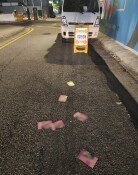Consumers Move to Sue Over Asbestos-tainted Talc
Consumers Move to Sue Over Asbestos-tainted Talc
Posted April. 15, 2009 07:44,
A class-action lawsuit is expected to be filed against manufacturers of domestically produced cosmetics that allegedly used asbestos-tainted talc.
Controversy has also erupted over the difficulty in measuring the immediate damage to a person since the effects of asbestos surface years later.
○ Consumers present demands
A civic group called A Gathering of Victims for a Class-action Lawsuit against Asbestos Baby Powder appeared on the Internet portal site Naver yesterday. It said it has filed a lawsuit against the government, powder manufacturers and talc suppliers to the Seoul Central District Court after recruiting 46 victims as a first step.
A combined 23 households are party to the lawsuit and seek 600,000 won (453 U.S. dollars) in damages per household.
We decided on the amount considering that the manufacturers said nothing of the asbestos-tainted talc, the government neglected its responsibility to supervise it, and consumers suffered emotional distress, said Kim Hyo-eun, the attorney for the group.
This is the minimum amount since the damage of asbestos-tainted powder on people does not appear immediately.
The Korean Federation for Environmental Movement held its first meeting with some 10 victims April 8. After collecting reports of damage on its homepage, the federation filed a lawsuit against the powder maker and talc supplier.
The federation will hold an emergency discussion on asbestos shock with many other civic groups at the National Assembly today. A federation source said, Dozens of cases are reported every day, and we plan to file a class-action lawsuit.
○ Manufacturer seeks lifting of sales ban
Manufacturers affected by the talc ban, however, are fighting the government. The Korea Pharmaceutical Manufacturers Association said it has a list of manufacturers wanting to join a class-action lawsuit against the Korean Food and Drug Administration, along with 24 companies taking part in the movement.
The manufacturers plan to ask for a preliminary injunction to lift the recall and disposal orders for asbestos-tainted products against the government watchdog.
Han Lim Pharmaceuticals is suing to lift the sales ban and recall orders with the Seoul Administrative Court.
Talc-tainted drugs that the agency announced are or will not be on the market, the company said. Despite being aware of this, the agency ordered a recall and ban without prior notice, causing tremendous damage to us.
Han Lim assumes the damage it suffered including losses from the sales ban, suspension of insurance benefits, and tainting of its image will exceed one trillion won (755 million dollars).
○ 3 key issues
Three major legal issues face consumers and manufacturers: how long and how much did the government or manufacturers know about asbestos-tainted talc; why preventive measures were delayed; and if manufacturers inflicted physical, psychological and asset damage to consumers.
Consumers who want to join the class-action lawsuit must provide receipts of product purchases and verification that they suffered side effects such as atopic dermatitis and other skin diseases after using the products. Since it is difficult to prove the immediate direct damage to a person, compensation for emotional distress is likely to become the most disputed issue.
In the class-action lawsuit for a personal information leak by a large company last year, 200,000 won (151 dollars) to 700,000 won (529 dollars) were awarded per person.
A compensation lawsuit can be filed when real damage is incurred by asbestos-tainted talc, said Park Gyo-sun of Shin&Kim, a Korean law firm defending Boryung Medience, which allegedly produced asbestos-tainted baby powder.
Since its not easy to determine that the government or manufacturers did something illegal or that consumers suffered damage, the legal dispute is expected to be intense.
bell@donga.com




![반찬통 착색 고민 끝…‘두부용기’ 버리지 말고 이렇게 쓰세요 [알쓸톡]](https://dimg.donga.com/c/138/175/90/1/wps/NEWS/IMAGE/2026/01/09/133126593.3.png)


